生物分离工程课件(英文版)
生物分离工程的英语

生物分离工程的英语Biological Separation Engineering is a specialized field that focuses on the isolation and purification of biological products. It plays a crucial role in the pharmaceutical, food, and biotechnology industries, where the extraction ofbioactive compounds from natural sources is essential.The process typically begins with the selection of an appropriate feedstock, which could be anything from plant material to microorganisms. Once the feedstock is identified, it undergoes a series of steps to separate the desired components. These steps may include:1. Pre-treatment: This involves breaking down the complex structure of the feedstock to release the target molecules. Techniques such as mechanical disruption, enzymatic digestion, or chemical treatment may be used.2. Extraction: The target molecules are then extractedfrom the pre-treated material. This can be done using solvent extraction, where a solvent is used to dissolve the desired compounds, or by using methods like supercritical fluid extraction, which employs high-pressure gases to extract the compounds.3. Concentration: After extraction, the solution is often diluted and needs to be concentrated to increase the concentration of the target molecules. This can be achievedthrough evaporation, membrane filtration, or centrifugation.4. Purification: The concentrated solution may still contain impurities, so further purification is necessary. Chromatography is a common technique used at this stage, which separates molecules based on their affinity to the stationary phase.5. Polishing: The final step is to polish the purified product to ensure it meets the required specifications. This may involve additional rounds of purification or the use of specific techniques to remove any remaining impurities.Biological separation engineering is a complex process that requires a deep understanding of both the properties of the target molecules and the various separation techniques available. Advances in this field are continually improving the efficiency and selectivity of these processes, making it possible to produce high-quality biological products for a wide range of applications.。
生物分离工程双语版8
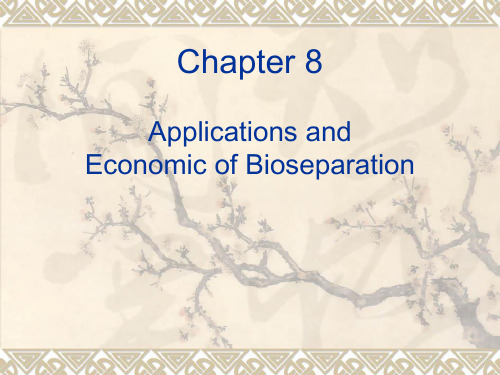
Centrifugation
1 In biotechnology, centrifugation is effectively used to separate products that exhibit very small differences in
Biotechnological product ready for market
❖ 1 conform to FDA standard ❖ 2 safe, potent and pure ❖ 3 stable in injectable form ❖ 4 minimize the number of steps while ❖ maintaining high yields and product purity, ❖ quality and activity ❖ A reduce the opportunity of product loss ❖ B minimize product contamination.
Chapter 8
Applications and Economic of Bioseparation
I Introduction
❖ Bioseparation and Downstream processing cost:
❖ (1) 50% (drug, protein, biological product) ❖ (2) 80% (recombinant protein) ❖ Ratio of recovery to fermentation cost ❖ (1) 2.0 (enzyme) ❖ (2) 1.0 penicillin ❖ (3) 0.16 (ethanol)
Downstream processing costs play a major role
生物分离工程-双语版 3
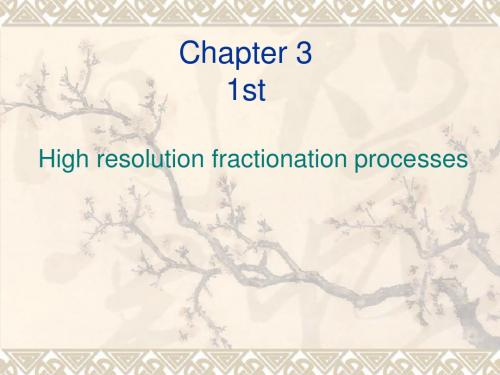
Difference between crude and purified esterase forms
(1)
Thiol-containing compounds in crude material lead to cysteine-containing protein denaturation (2) Proteolysis activity in crude material (3) Coprecipitation with less stable compounds in crude material (4) Conformational changes in processing steps
Exmaple 3.1 carboxylesterase purification
(4) Reason A active monomer associating multiple forms B multiple form have different chromatography and electrophoretic properties C reaction equilibrium affected by pH, salt concentration, enzyme dilution D monomers or multimeric enzyme forms affect activity and stability
t-PA frourification for CHO and 16 steps E.coli. (2) Affinity chromatography and gel chromatography used in the end of purification process to remove impurities and salts (3) t-PA purity greater than 99.5% (4) Clearance of endotoxin with 99.999% (5) Drop in product yield ( refolding 20%, ultrafiltration 56%
生物分离工程第二章PPT课件

16
差 速 离 心
17
18
主要菌体和细胞的离心分离
菌体、细胞
大肠杆菌 酵母 血小板 红血球 淋巴球 肝细胞
大小/μm
51
高压匀浆法适用于酵母和大多数细菌细胞的 破碎,料液细胞浓度可达到20%左右。团状 和系状菌易造成高压匀浆器堵塞,一般不宜 使用高压匀浆法。高压匀浆操作的温度上升 约2~ 3℃/10MPa,为保护目标产物的生物 活性,需对料液作冷却处理,多级破碎操作 中需在级间设置冷却装置。因为料液通过匀 浆器的时间很短,通过匀浆器后迅速冷却, 可有效防止温度上升,保护产物活性。
(2)过滤阻力:
• 介质阻力 • 滤饼阻力
• 大多情况下,过滤阻力主要取决于滤饼 阻力。
33
(3)过滤速率
dQ dt
A p
L Rm Rc
Rm表示介质的阻力; Rc表示滤饼的阻力; μL为滤液的粘度
34
(4)过滤速度的强化
a.降低滤饼阻力
• 如絮凝剂、凝固剂助滤剂等。
b.降低滤液黏度μ
• 黏度愈低,过滤阻力愈小。加热、去杂蛋白、絮凝、 调pH、选择合适的放罐时间。
过滤介质 : 过滤采用的多孔物质。
织物状介质,棉花、石棉、蚕丝、麻、
羊毛及各种人造纤维与金属丝等
多孔陶瓷介质,此为特殊的介质,低温
烧制,具有大量微细孔道的滤管或滤板 (其他多孔材料,PE等)
膜分离介质,微滤分离等
32
(1)过滤推动力:
• 悬浮液自身压强差、重力 • 悬浮液的—外加压力 • 过滤介质的—抽真空 • 离心力
Chapter 3 Flocculation & Sedimentation 3b
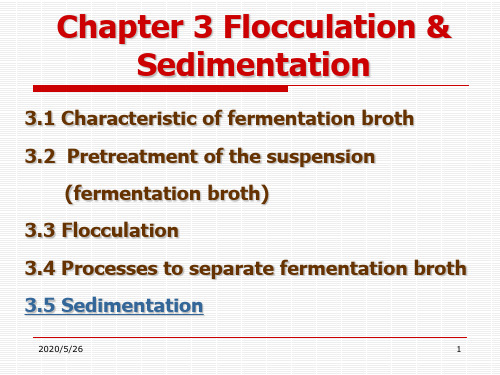
2011-5-22
16
3.5.2 Sedimentation principles
Calculated settling velocities and Reynolds number for example Bioproducts (Assumes ρ0 = 1.0 g/cm3 and µ = 1.0 cp)
6
2011-5-22
3.5.2 Sedimentation principles
4 3 FbR = π a ρ0ω2 R Centrifugal field: 3 4 3 Gravitational field: F = π a ρ0 g bR 3
FdR
FdR = −Cd A
FIR
ρv
2
2
= −πa Cd
In bioseparations, the centrifugal field is usually selected. Why?
2011-5-22 14
3.5.2 Sedimentation principles
If the R is not constant (the particle is moving outward from the center of rotation in a centrifuge) and
Bioparticle or biomolecule Yeast cell Bacteria cell Protein Sedimentation Density, radius, a (µm) ρ(g/cm3) 2.5 0.5 0.005 1.1 1.1 1.3 Dimensionless Sedimentation Reynolds acceleration velocity, v number, (G), ω2R/g (cm/h) Re 1 1 104 0.5 0.02 0.06 7×10-6 × 6×10-8 × 2×10-9 ×
生物分离工程膜分离过程 (membrane separation幻灯片课件

▪ 透析法在临床上常用于肾衰竭患者的血液透析。 ▪ 在生物分离方面,主要用于大分子溶液的脱盐。由于
透析过程以浓差为传质推动力,膜的透过量很小,不 适于大规模生物分离过程、但在实验室中应用较多。
膜分离过程 (membrane separation)
▪ 膜的制造
17.2 膜的制造
▪ 要求: ▪ (1)透过速度 ▪ (2)选择性 ▪ (3) 机械强度 ▪ (4) 稳定性
▪ 分离机理
毛细管流动模型 在膜过滤法中,反渗透和超滤与微滤有不同的分离机理。对于后两者,一般认为是简单的 筛分过程,大于膜表面毛细孔的分子被截留,相反,较小的分子则能透过膜。膜是多孔性的 ,膜内有很多孔道。水以滞流方式在孔道内流动,因而服从Hagen-Poiseuille方程式;
Jv d 2 p 32 L
膜分离过程 (membrane separation)
▪ 浓差极化与膜污染及清洗方法
什么是浓差极化?
▪ 在分离过程中,料液中溶剂在压力驱动下透过膜,溶
质被截留,于是在膜表面与临近膜面区域浓度越来越 高。在浓度梯度作用下,溶质由膜面向本体溶液扩散, 形成边界层,使流体阻力与局部渗透压增加,从而导 致溶液透过流量下降。溶剂向膜面流动(对流)引起溶 质向膜面流动,当溶质向膜面的流动速度与浓度梯度 使溶质向本体溶液扩散速度达到平衡时,在膜面附近 存在一个稳定的浓度梯度区,这一区域称为浓度极化 边界层,这一现象称为浓差极化。
生物分离工程膜分离过程 (membrane separation
膜分离过程 (membrane separation)
第一讲
膜分离过程 (membrane separation)
▪ 膜分离过程的类型
▪ 按分子或粒子大小分类 ▪ 按膜孔平均孔径,推动力和传递机制进行分类 ▪ 对称膜与不对称膜 ▪ 有孔膜与无孔膜
生物分离工程-双语版 2
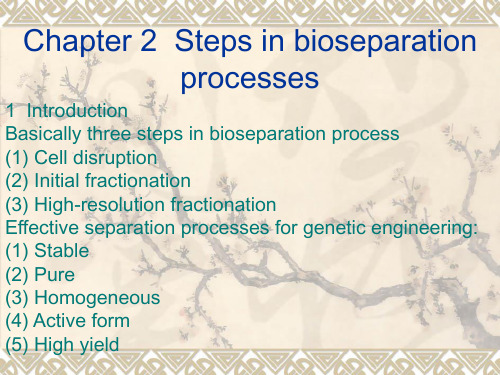
1 Introduction
❖ Considering protein properties for bioseparation
❖ (1) size ❖ (2) charge ❖ (3) biological affinity ❖ (4) hydrophobicity-solubility
❖ Products from mammalian cell techniques
hydrolyzed to peptides) ❖ G Mishaelis-Menten kinetic equation predict cell wall lysis ❖ H production of food grade single cell protein
New words and vocabulary
1 Introduction
❖ Three factors of designing bioseparation processes ❖ (1) purity ❖ (2) cost ❖ (3) market ❖ Material state and choice of separation methods ❖ Material secreted ( ultrafiltration, centrifugation) ❖ Not secreted material (cell disruption, solid-liquid
II Product excretion from the cell or cell disruption
❖Excreted protein advantage
❖ (1) contamination level low ❖ (2) easy downstream processing steps ❖ (3) not require cell disruption ❖ (4) avoid handling viscous fluids and proteinase
生物分离工程公开课一等奖优质课大赛微课获奖课件

第6页
胶团和反胶团形状
micelles
Reverse micelles
表面活性剂分子汇集使反胶团内形成极性核(polar core), 因此有机溶剂中反胶 团可溶解水。反胶束内溶解水通常称为微水相或“水池”(water pool)
第7页
子提供易于生存亲水微环境. 因此,反胶团萃取可用于氨基酸、肽和蛋白
质等生物分子分离纯化, 尤其是蛋白质类生物大分子。
蛋白质溶解模型:
a、水壳模型: 蛋白质位于水池中心,
周围存在水层将其与反胶团壁隔开;
b、半岛模型: 蛋白分子表面存在强
烈疏水区,该区直接与有机相接触;
c、蛋白吸附于反胶团内壁;
d、蛋白疏水区与几种反胶团S疏水
Diameter of “Water Pool”
反胶束大小与溶剂和S种类与浓度、温度、离子强 度等原因相关, 普通为5-20nm
反胶束不是刚性球体, 而是热力学稳定汇集体; 在有机相中反胶束以非常高速度生成和破灭, 不断地 互换其构成份子(表面活性剂和水), 速率常数约 106~107m3/kmol·s
临界胶束浓度(critical micelle concentration,CMC): 表面活性剂在水溶 剂中形成胶束最低浓度
第5页
有机溶剂中反胶团
反胶团(reversed micelle)
Cross section
反胶团(reverse micelles): 若向有机溶剂(油)中加入油溶性表面活性剂, 当 [S]超出一定值时, S在有机溶剂中也会形成胶团。通常将S在有机溶剂中形成 胶团称为反胶团, 也称反胶束或反微团
AOT在异辛烷中形成反胶团直径:
生物分离工程-双语版 7
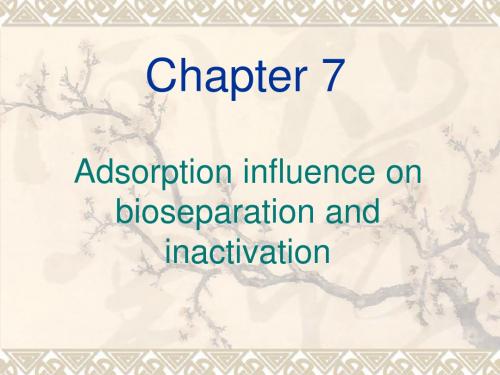
Adsorption of proteins at interface
2 Proteins undergo a change from globular conformation to an extended chain 3 Adsorption of proteins-enzyme at interface is a complex phenomenon (1) transport to the interface by diffusion, convection, mixing and shearing action (2) adsorption-desorption at interface A interfacial chemical reaction B kinetic adsorption and desorption mechanisms (3) structural change of molecules in contact with interface (4) adsorption competition between molecules of different nature or molecular weight
Factors of influencing protein adsorption onto surface
1
Protein adsorption kinetics 2 Chemical equilibrium between interfacial protein and solution proteins 3 Flow of protein past adsorbing surface 4 Conformation of proteins in the adsorbed layer
生物分离工程1生物分离工程概述08.ppt.Convertor
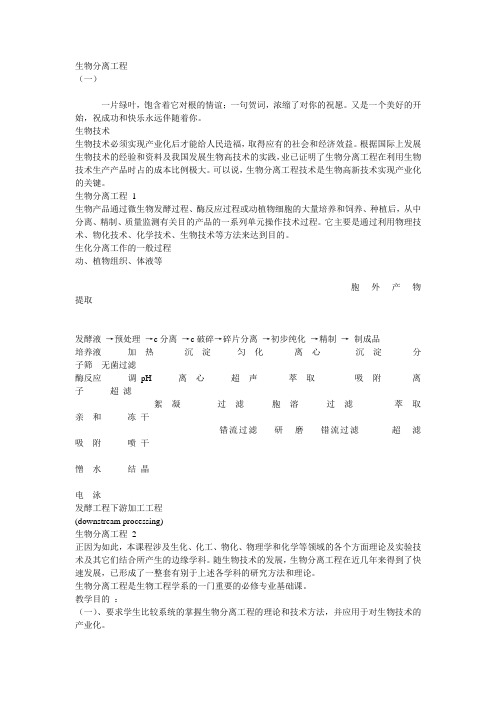
生物分离工程(一)一片绿叶,饱含着它对根的情谊;一句贺词,浓缩了对你的祝愿。
又是一个美好的开始,祝成功和快乐永远伴随着你。
生物技术生物技术必须实现产业化后才能给人民造福,取得应有的社会和经济效益。
根据国际上发展生物技术的经验和资料及我国发展生物高技术的实践,业已证明了生物分离工程在利用生物技术生产产品时占的成本比例极大。
可以说,生物分离工程技术是生物高新技术实现产业化的关键。
生物分离工程 1生物产品通过微生物发酵过程、酶反应过程或动植物细胞的大量培养和饲养、种植后,从中分离、精制、质量监测有关目的产品的一系列单元操作技术过程。
它主要是通过利用物理技术、物化技术、化学技术、生物技术等方法来达到目的。
生化分离工作的一般过程动、植物组织、体液等胞外产物提取发酵液→预处理→c分离→c破碎→碎片分离→初步纯化→精制→制成品培养液加热沉淀匀化离心沉淀分子筛无菌过滤酶反应调pH 离心超声萃取吸附离子超滤絮凝过滤胞溶过滤萃取亲和冻干错流过滤研磨错流过滤超滤吸附喷干憎水结晶电泳发酵工程下游加工工程(downstream processing)生物分离工程 2正因为如此,本课程涉及生化、化工、物化、物理学和化学等领域的各个方面理论及实验技术及其它们结合所产生的边缘学科。
随生物技术的发展,生物分离工程在近几年来得到了快速发展,已形成了一整套有别于上述各学科的研究方法和理论。
生物分离工程是生物工程学系的一门重要的必修专业基础课。
教学目的:(一)、要求学生比较系统的掌握生物分离工程的理论和技术方法,并应用于对生物技术的产业化。
(二)、通过对生物分离工程的学习,使学生能综合利用已学会的化学、物理学、生物化学、物理化学、化工原理等知识,为今后学习生物产品工艺学等打好基础,开拓思路及走上工作岗位后能在实际工作时应用生物分离工程各种技术做好理论准备。
教学目的:(三)、要求学生掌握有关产品后处理采用各单元操作的常用手段,并初步掌握其理论知识,如:盐析、结晶、离子交换、萃取、离心等。
- 1、下载文档前请自行甄别文档内容的完整性,平台不提供额外的编辑、内容补充、找答案等附加服务。
- 2、"仅部分预览"的文档,不可在线预览部分如存在完整性等问题,可反馈申请退款(可完整预览的文档不适用该条件!)。
- 3、如文档侵犯您的权益,请联系客服反馈,我们会尽快为您处理(人工客服工作时间:9:00-18:30)。
Solid product Liquid product Formulation Sterile ultrafiltration Polishing ultrafiltration Formulation Liquids or solids Drying Rotary filter Kerosene and tertiary amine Water Activated carbon CaCl and polyelectrolyte
4. The Objective of the Cour se
(1) Master ing main separ ation oper ations (2) Pr ocess design : developing a engineer ing solution to a given pr oblem under multidisciplinar y envir onment (3) Appar atus design : Scaling up/down or innovation, and Pr oduct design (4) Captur ing the science unity under lying diver sified separ ation oper ations
2. Characteristics of Bioseparations
2. Characteristics of Bioseparations
1. What is Bioseparations? 2. Characteristics of Bioseparations 3. General industrial bioseparation processes 4. The Objective of the Course 5. Content of this course
3. General industrial bioseparatindustrial bioseparation processes
Downstr eam pr ocesses for pr oduction of antibiotic
Pr oduction of r ecombinant human alpha-1-antitr ypsin (
T=5 Bioreactor fluid with cells Filtration fitrate Extraction pH2-3 Back extraction adsorption Spent solvent
Product
Precipitation B-Chain Dialysis
Drying centrifugation Crystallization Filtration Ion exchange
Precipitation A-Chain
Sulfonation
Precipitation
Extraction Downstr eam pr ocessing for pr oduction of liquid or solid pr otease
Recover y and pur ification of human insulin
2001
Homework
Fr iday, 3:00~5:00PM Room B102 or B105, Chemical engineer ing Building
A detailed summary ( 1000-2000 words) 1000of today's topic and any advice today' about the course.
(1) Characteristics of biochemicals or bioproducts
Tremendous variety of products ( )
) )
Biological (or chemical) activity ( low concentr ation of the tar gets (
What is the value of the product? ( ( ) ) What is an acceptable product quality? Where is the product and impurities in each process stream? ( )
What are the unusual physicochemical
Chromatography
Cool to 4-5 Filter aid Bioreactor fluid pretreatment Chromatography Cells Filtration or centrifugation Two-stage ultrafiltration precoat Ultrafiltration
Downstr eam pr ocessing of citr ic acid
3. General industrial bioseparation processes
3. General industrial bioseparation processes
Unit oper ations above pr ocesses include: Filtr ation Centr ifugation Adsor ption Solvent extr action Chr omatogr aphy Ion exchange Dr ying Cr ystallization and pr ecipitation etc.
Fer mentation br oth being a complicated mixtur e (complex components) (
Poor stability (
) )
How to lower them?
Important!
The recovery and the purification processes must be well conceived and well designed!
3. General industrial bioseparation processes
(1) Removal of insolubles. Filtration, centrifugation (2) Isolation of products Adsorption, solvent extraction (3) Purification Chromatography, electrophoresis, precipitation (4) Polishing Crystallization, drying, etc.
properties of the product and the principal impurities?
( )
What are the economics of various alternative separations?
( )
Careful consideration of these questions can help us to determine the optimal separating processes.
References
1. Biosepar ations Science and Engineer ing, Roger G. Har r ison, et. al , Oxfor d Univer sity Pr ess, Inc., New Yor k Oxfor d, 2003 2. 2005
6. References 7. Question answering
(2) Characteristics of Bioseparations
Broad spectrum of separation methods most bioseparation methods come from separations of chemicals These separations are elaborate and expensive
)
3. General industrial bioseparation processes
3. General industrial bioseparation processes
3. General industrial bioseparation processes
Bioreactor fluid with cells Cell disruption Cell debris Centrifugal extraction supernatant Dialysis Cleaning pro insulin
High pur ity and str ict sanitation cr iter ion
2. Characteristics of Bioseparations 2. Characteristics of Bioseparations
So, Before designing, the questions we should ask and answer are:
5. Content of this course
Chapter 1 Intr oduction Chapter 2 Cell disr uption Chapter 3 Flocculation & Sedimentation Chapter 4 Filtr ation & Membr ane Separ ations Chapter 5 Extr action Chapter 6 Adsor ption & Chr omatogr aphy Chapter 7 Cr ystallization and Pr ecipitation Chapter 8 New separ ation methods
